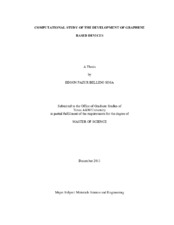| dc.description.abstract | Graphene is a promising material for many technological applications. To realize these applications, new fabrication techniques that allow precise control of the physical properties, as well as large scale integration between single devices are needed. In this work, a series of studies are performed in order to develop graphene based devices. First, using MD simulations we study the effects of irradiating graphene with a carbon ion atom at several positions and energies from 0.1 eV to 100 keV. The simulations show four types of processes adsorption, reflection, transmission, and vacancy formation. At energies below 10 eV the dominant process is reflection, between 10 and 100 eV is adsorption, and between 100 eV and 100 keV the dominant process is transmission. Vacancy formation is a low rate process that takes place at energies above 30 eV.
Three types of defects were found: adatom, single vacancy, and 5-8-5 defect formed from a double vacancy defect. Also a bottom-up fabrication method is studied, in this method, the controlled folding of graphene structures, driven by molecular interactions with water nanodroplets, is analyzed considering the interactions with substrates such as SiO2, HMDS and IPA on SiO2. When the graphene is supported on SiO2, the attraction between graphene and the substrate prevents graphene from folding but if the substrate has HMDS or IPA, the interaction between graphene and the substrate is weak, and depending on the geometry of the graphene structure, folding is possible. Finally, to evaluate the characteristics of graphene based devices, we model the vibrational bending modes of graphene ribbons with different dimensions. The resonant frequencies of the ribbons and relations between the size of the ribbon and their resonant frequencies are calculated. The interaction of a graphene vibronic device with water and IPA molecules are simulated and demonstrate that this device can be used as a sensitive vibronic molecular sensor that is able to distinguish the chemical nature of the detected molecule. Also, the electrical properties of the graphene vibronic with armchair and zigzag border are calculated; the latter has the potential to generate THz electrical signals as demonstrated in this work. | en |


